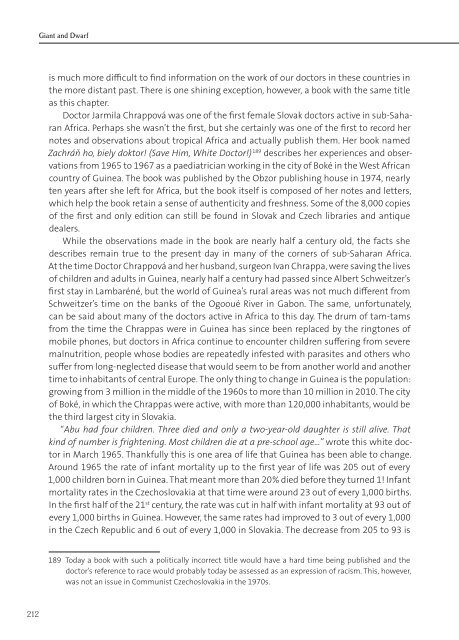Giant_and_Dwarf-FIN
Giant_and_Dwarf-FIN
Giant_and_Dwarf-FIN
You also want an ePaper? Increase the reach of your titles
YUMPU automatically turns print PDFs into web optimized ePapers that Google loves.
<strong>Giant</strong> <strong>and</strong> <strong>Dwarf</strong>is much more difficult to find information on the work of our doctors in these countries inthe more distant past. There is one shining exception, however, a book with the same titleas this chapter.Doctor Jarmila Chrappová was one of the first female Slovak doctors active in sub-SaharanAfrica. Perhaps she wasn’t the first, but she certainly was one of the first to record hernotes <strong>and</strong> observations about tropical Africa <strong>and</strong> actually publish them. Her book namedZachráň ho, biely doktor! (Save Him, White Doctor!) 189 describes her experiences <strong>and</strong> observationsfrom 1965 to 1967 as a paediatrician working in the city of Boké in the West Africancountry of Guinea. The book was published by the Obzor publishing house in 1974, nearlyten years after she left for Africa, but the book itself is composed of her notes <strong>and</strong> letters,which help the book retain a sense of authenticity <strong>and</strong> freshness. Some of the 8,000 copiesof the first <strong>and</strong> only edition can still be found in Slovak <strong>and</strong> Czech libraries <strong>and</strong> antiquedealers.While the observations made in the book are nearly half a century old, the facts shedescribes remain true to the present day in many of the corners of sub-Saharan Africa.At the time Doctor Chrappová <strong>and</strong> her husb<strong>and</strong>, surgeon Ivan Chrappa, were saving the livesof children <strong>and</strong> adults in Guinea, nearly half a century had passed since Albert Schweitzer’sfirst stay in Lambaréné, but the world of Guinea’s rural areas was not much different fromSchweitzer’s time on the banks of the Ogooué River in Gabon. The same, unfortunately,can be said about many of the doctors active in Africa to this day. The drum of tam-tamsfrom the time the Chrappas were in Guinea has since been replaced by the ringtones ofmobile phones, but doctors in Africa continue to encounter children suffering from severemalnutrition, people whose bodies are repeatedly infested with parasites <strong>and</strong> others whosuffer from long-neglected disease that would seem to be from another world <strong>and</strong> anothertime to inhabitants of central Europe. The only thing to change in Guinea is the population:growing from 3 million in the middle of the 1960s to more than 10 million in 2010. The cityof Boké, in which the Chrappas were active, with more than 120,000 inhabitants, would bethe third largest city in Slovakia.“Abu had four children. Three died <strong>and</strong> only a two-year-old daughter is still alive. Thatkind of number is frightening. Most children die at a pre-school age...” wrote this white doctorin March 1965. Thankfully this is one area of life that Guinea has been able to change.Around 1965 the rate of infant mortality up to the first year of life was 205 out of every1,000 children born in Guinea. That meant more than 20 % died before they turned 1! Infantmortality rates in the Czechoslovakia at that time were around 23 out of every 1,000 births.In the first half of the 21 st century, the rate was cut in half with infant mortality at 93 out ofevery 1,000 births in Guinea. However, the same rates had improved to 3 out of every 1,000in the Czech Republic <strong>and</strong> 6 out of every 1,000 in Slovakia. The decrease from 205 to 93 is189 Today a book with such a politically incorrect title would have a hard time being published <strong>and</strong> thedoctor’s reference to race would probably today be assessed as an expression of racism. This, however,was not an issue in Communist Czechoslovakia in the 1970s.212


